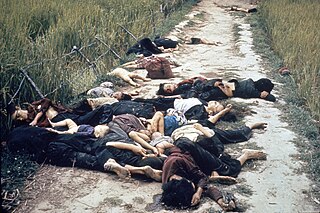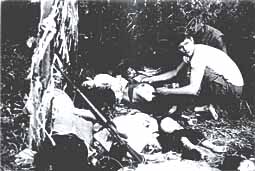 W
WThe Bình Hòa Massacre was a massacre purportedly conducted by South Korean forces between December 3 and December 6, 1966, of 430 unarmed citizens in Bình Hòa village, Quảng Ngãi Province in South Vietnam. In 2000, however, it was reported that a monument within the village, gave the dates of the massacre as October 22, 24, and 26, 1966 and said that 403 people were killed by the South Koreans.
 W
WThe Bình Tai Massacre was a massacre allegedly perpetrated by South Korean Forces on 9 October 1966 of 29-168 citizens in Binh Tai village of Bình Định Province in South Vietnam.
 W
WThe Hà My Massacre was a massacre purportedly conducted by the South Korean Marines on 25 February 1968 of unarmed citizens in Hà My village, Điện Dương commune, Điện Bàn District, Quảng Nam Province in South Vietnam.
 W
WThe Mỹ Lai massacre was the Vietnam War mass murder of unarmed South Vietnamese civilians by U.S. troops in Sơn Tịnh District, South Vietnam, on March 16, 1968. Between 347 and 504 unarmed people were killed by U.S. Army soldiers from Company C, 1st Battalion, 20th Infantry Regiment and Company B, 4th Battalion, 3rd Infantry Regiment, 11th Brigade, 23rd (Americal) Infantry Division. Victims included men, women, children, and infants. Some of the women were gang-raped and their bodies mutilated, as were children as young as 12. Twenty-six soldiers were charged with criminal offenses, but only Lieutenant William Calley Jr., a platoon leader in C Company, was convicted. Found guilty of killing 22 villagers, he was originally given a life sentence, but served only three-and-a-half years under house arrest.
 W
WThe Phong Nhị and Phong Nhất massacre was a massacre reported to have been conducted by the 2nd Marine Brigade of the Republic of Korea Marines (ROKMC) on 12 February 1968 of unarmed citizens in the villages of Phong Nhị and Phong Nhất, Điện Bàn District of Quảng Nam Province in South Vietnam. The South Korean forces had been newly transferred from the area, in the wake of the Tet Offensive, with the village located in a densely populated region in and around Da Nang. Transferring Korean Marines to the populated Da Nang sector from a less populated sector was unpopular with ARVN and US Commanders and setting back pacification and relation-building efforts, due to the behaviour of Korean forces.
 W
WThe Russell Tribunal, also known as the International War Crimes Tribunal, Russell-Sartre Tribunal, or Stockholm Tribunal, was a private People's Tribunal organised in 1966 by Bertrand Russell, British philosopher and Nobel Prize winner, and hosted by French philosopher and writer Jean-Paul Sartre, along with Lelio Basso, Ken Coates, Ralph Schoenman, Julio Cortázar and several others. The tribunal investigated and evaluated American foreign policy and military intervention in Vietnam. This had taken place in the decade following the 1954 defeat of French forces at Diên Biên Phu and the establishment of North and South Vietnam.
 W
WThe Sơn Thắng massacre, [ʂəːŋ˧˧ tʰaŋ˦˧˥]) was a massacre conducted by the United States Marine Corps during Operation Imperial Lake on 19 February 1970, in which five women and 11 children were killed. The Marines reported the civilians killed as being Vietcong (VC) killed in a firefight. These incidents were reported by civilians and charges were brought up against the Marines. Four Marines were court-martialled and one was sentenced to 5 years in prison and the other to life, but Major General Charles F. Widdecke reduced each sentence to less than year.
 W
WOperation Speedy Express was a controversial U.S. Army 9th U.S. Infantry Division operation of the Vietnam War conducted in the Mekong Delta provinces Kiến Hòa and Vĩnh Bình. The operation, led by Major General Julian J. Ewell, was part of US military "pacification" efforts against the Viet Cong (VC). The US military sought to interdict lines of VC communication and deny them the use of base areas. At least 5,000 to 7,000 casualties were reported to have been civilians.
 W
WThe Thanh My Massacre was a massacre of South Vietnamese civilians committed by the Viet Cong (VC) during the Vietnam War, in Thanh My hamlet, Phu Thanh village, Quảng Nam Province, South Vietnam on 11 June 1970. The hamlet, which was pro-government and defended by US Marines and South Vietnamese militia, was attacked by the VC in the early morning of 11 June. Under cover of a mortar barrage VC sappers set fire to houses and killed civilians either by shooting to throwing explosives into their shelters. The Marines and South Vietnamese forces engaged with the VC and called in artillery support. By 03:15 the VC began to withdraw and the Marines reoccupied the village and began evacuating the wounded.